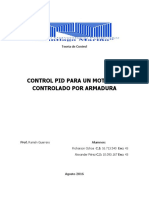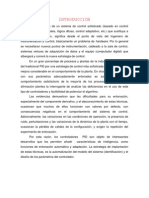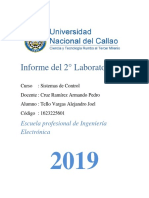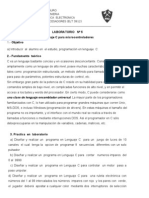Reporte P3
Reporte P3
Cargado por
Alan AlvaradoCopyright:
Formatos disponibles
Reporte P3
Reporte P3
Cargado por
Alan AlvaradoTítulo original
Derechos de autor
Formatos disponibles
Compartir este documento
Compartir o incrustar documentos
¿Le pareció útil este documento?
¿Este contenido es inapropiado?
Copyright:
Formatos disponibles
Reporte P3
Reporte P3
Cargado por
Alan AlvaradoCopyright:
Formatos disponibles
INSTITUTO TECNOLÓGICO DE MORELIA
“JOSÉ MARÍA MORELOS Y PAVÓN”
CONTROL
INGENIERÍA EN MECATRÓNICA
PRÁCTICA 3:
CONTROLADOR INTEGRADOR PARA UN SISTEMA DE
PRIMER ORDEN
PRESENTA:
ALAN ALVARADO RAMÍREZ 17121109
ASESOR:
DR. JOHAN WALTER GONZÁLEZ MURUETA
MORELIA, MICHOACÁN 20 DE JUNIO DEL 2021
I. RESUMEN
Durante este trabajo se analizaron los componentes electrónicos que comprenderían el
armado en físico de un sistema de control en lazo cerrado, cada componente por separado (a
los que se les hicieron algunas modificaciones para observar su comportamiento) y al final
se diseñó un sistema lazo cerrado con un controlador Integrador y varias especificaciones
dadas para poder solucionar las necesidades presentadas como lo era la respuesta más lenta
del sistema.
Después de hacer un pequeño análisis y cálculos teóricos, se utiliza el software “multisim”
para hacer las simulaciones requeridas y se les aplicó un análisis transitorio para observar su
comportamiento mediante una gráfica y poder hacer comparaciones y mediciones.
II. ABSTRACT
During this work, the electronic components that would include the physical assembly of a
closed-loop control system were analyzed, each component separately (to which some
modifications were made to observe their behavior) and in the end a closed-loop system was
designed with a Integral controller and several specifications given in order to solve the
presented need such as slowing down the response .
After developing an analysis and theoretical calculations, the "multisim" software is used to
perform the required simulations and a transitory analysis was applied to them to observe
their behavior through a graph and to be able to make comparisons and measurements.
Alan Alvarado Ramírez
III. INTRODUCCIÓN
Todos los sistemas de control contienen una planta, un controlador, una entrada y una salida.
Durante el ciclo de control de cualquier sistema es de especial interés el saber de antemano
el comportamiento del sistema para, de esta manera, poder manejarlo y/o modificarlo a
nuestra conveniencia y así aprovecharlo al máximo. Por lo anterior es necesario exponer el
análisis teórico y práctico de distintos componentes y de sistemas de control y su
comparación en este trabajo.
El objetivo de la práctica es simular mediante el software “multisim” distintos circuitos por
separado con distintos requerimientos para observar su comportamiento y hacer
comparaciones con resultados teóricos, además de simular el comportamiento de un sistema
de control en lazo cerrado con un controlador Integrador diseñado teóricamente para
comprobar su comportamiento mediante un análisis de la gráfica de salida.
El tiempo es la variable independiente que se usa en los sistemas de control, por ello, es de
especial interés el análisis de las respuestas de los sistemas y sus salidas, las respuestas en el
tiempo se pueden dividir en [1]:
• Respuesta transitoria: Se define como la parte de la respuesta en el tiempo que tiende
a cero cuando el tiempo se hace muy grande. Representa el comportamiento dinámico del
sistema y debe controlarse de acuerdo a los requerimientos hasta que se alcance el estado
estable.
• Respuesta en estado estable: Es la parte de la respuesta total que permanecerá después
que la transitoria ha desaparecido. Indica la salida final del sistema cuando el tiempo se hace
muy grande, si existe una diferencia entre la referencia deseada y la salida se dice que se
tiene un error en estado estable.
Por tanto, la respuesta del sistema c(t) se puede escribir como:
𝑐(𝑡) = 𝑐𝑡𝑟 + 𝑐𝑠𝑠 (𝑡)
donde el primer término del miembro derecho de la ecuación es la respuesta transitoria y el
segundo término es la respuesta en el estado estacionario [2].
Alan Alvarado Ramírez
El esquema general de un sistema de control lazo cerrado de primer orden se presenta en la
figura 1.
Fig. 1. Comportamiento de un sistema de control lazo cerrado de primer orden.
El comportamiento de un sistema de lazo cerrado de primer orden es el presentado en la Fig.
2, donde se puede observar que se alcanza el 95% de su nivel máximo estable en 3T, lo que
indica que el cálculo de su período es de suma importancia para poder determinar el tiempo
en que se alcanza la estabilidad [4].
Fig. 2. Comportamiento de un sistema de control lazo cerrado de primer orden.
Alan Alvarado Ramírez
Un controlador de acción integral es aquel en el que el valor de la acción de control es
proporcional a la integral de la señal de error, por lo que en este tipo de control la acción
varia en función de la desviación de la salida y del tiempo en el que se mantiene la desviación.
Si consideramos que:
• y(t)= Salida integral
• e(t)= Error (diferencia entre el valor de la medición y el esperado)
• 𝑇𝑖 = Tiempo integral
La salida de este controlador es:
1
𝑦(𝑡) = ∫ 𝑒(𝑡)𝑑𝑡
𝑇
Que convertido en LaPlace queda:
1
𝑌(𝑠) = 𝐸(𝑠)
𝑇𝑖 𝑠
Y su función de transferencias será:
𝑌(𝑠) 1
𝐺(𝑠) = =
𝐸(𝑠) 𝑇𝑖 𝑠
Lo anterior se puede ver expresado en la figura 3:
Fig. 3. Comportamiento del controlador integral en un sistema.
Alan Alvarado Ramírez
Cabe resaltar que la respuesta del sistema de control dependerá del valor de 𝐾𝑖 que es la
pendiente de la rampa de acción integral.
El inconveniente de este tipo de controlador es que la respuesta inicial es muy lenta y, el
controlador no empieza a ser efectivo hasta haber transcurrido cierto tiempo. En cambio,
anula el error remanente que presenta el controlador proporcional.
IV. MATERIALES Y METODOLOGÍA
Los materiales usados en este trabajo fueron únicamente una computadora y el
software Multisim para realizar las simulaciones y análisis transitorios requeridos.
La metodología que se siguió fue la siguiente:
En primer lugar, se observaron detenidamente los requerimientos y las fórmulas
dadas para cada inciso, para de esta manera hacer los cálculos teóricos con las
variables requeridas y mostrar los resultados de los cálculos, para después proceder a
armar los circuitos en el software y por último realizar las simulaciones en el mismo
con la herramienta análisis transitorio que muestra las gráficas del comportamiento
de la simulación.
Para el inciso 1, primeramente, se definieron los valores de la resistencia y del
capacitor a usar en los cálculos, para de esta manera comenzar los despejes y obtener
los resultados requeridos para poder obtener los datos que se pedían. Posteriormente
se procedió a armar el circuito en el software y usar la herramienta análisis transitorio
para observar la gráfica de comportamiento dependiendo el tipo de señal de entrada
(senoidal, cuadrada y triangular). Posteriormente se prosiguió a realizar el cálculo de
la función de transferencia del circuito realizado y se corrobora con la fórmula general
de un amplificador inversor.
Para el inciso 2 se definieron los valores de la resistencia y del capacitor a usar en los
cálculos, después se prosiguió realizar las ecuaciones y cálculos necesarios para
obtener los resultados requeridos. Después se armó el circuito en el software y se usó
Alan Alvarado Ramírez
la herramienta análisis transitorio para observar la gráfica de comportamiento.
Mediante la gráfica de comportamiento se pudo obtener por medio del análisis visual
de la misma, su T y K simuladas para posteriormente con una analogía de fórmulas
obtener su polo de forma práctica y realizar las comparaciones necesarias.
Para el inciso 3, en primera instancia se hicieron los cálculos de Gs a partir de Gp y
de Gc, para posteriormente evaluar con la condición de magnitud y sustituyendo en s
por el valor de nuevo polo (en este caso uno más pequeño para hacerlo más lento
como se solicita). Al aplicar la evaluación de magnitud y la sustitución anteriormente
mencionada, se calcula el valor de la ganancia para el sistema buscado. Por último se
procede a construir los circuitos en el software Multisim y simular su comportamiento
en las condiciones requeridas.
V. RESULTADOS
INSTRUCCIONES:
Alan Alvarado Ramírez
a.1 Con señal senoidal
Fig. 4. Circuito simulado para el ejercicio 1 con entrada senoidal.
Fig. 5. Análisis transitorio del circuito restador del ejercicio 1 con entrada senoidal.
Alan Alvarado Ramírez
a.2 Con señal cuadrada
Fig. 6. Circuito simulado para el ejercicio 1 con entrada cuadrada.
Fig. 7. Análisis transitorio del circuito restador del ejercicio 1 con entrada cuadrada.
Alan Alvarado Ramírez
a.3 Con señal triangular
Fig. 8. Circuito simulado para el ejercicio 1 con entrada triangular.
Fig. 9. Análisis transitorio del circuito restador del ejercicio 1 con entrada triangular
Alan Alvarado Ramírez
b. Para el cálculo de la función de transferencia:
𝑣𝑖𝑛 (𝑡) 𝑑𝑣𝑜𝑢𝑡 (𝑡)
= 𝑖𝑅1 = −𝐶1 ∗
𝑅1 𝑑𝑡
𝑑𝑣𝑜𝑢𝑡 (𝑡)
𝑣𝑖𝑛 (𝑡) = −𝑅1 𝐶1
𝑑𝑡
∫ 𝑣𝑖𝑛 (𝑡) = −𝑅1 𝐶1 𝑣𝑜𝑢𝑡 (𝑡)
1
𝑣𝑜𝑢𝑡 (𝑡) = − ∫ 𝑣𝑖𝑛 (𝑡)
𝑅1 𝐶1
Y transformando con LaPlace:
1 𝑣𝑖𝑛 (𝑠)
𝑣𝑜𝑢𝑡 (𝑠) = −
𝑅1 𝐶1 𝑠
𝑣𝑜𝑢𝑡 1
=−
𝑣𝑖𝑛 𝑅1 𝐶1 𝑠
Además, se corrobora el resultado obtenido con la fórmula general de un
amplificador inversor:
1
𝑣𝑜𝑢𝑡 𝑍2 𝐶1 𝑠 1
=− =− =−
𝑣𝑖𝑛 𝑍1 𝑅1 𝐶1 𝑠𝑅1
Se usan una resistencia con valor de 10k𝛺, un capacitor con valor de 10𝑛F y una
fuente cuadrada de 0 a 5v:
𝑉0 (𝑠) 1 𝑉0 (𝑠) 1 1
= ∴ = =
𝑉𝑖 (𝑠) 𝑅𝐶𝑠 + 1 𝑉𝑖 (𝑠) (10𝑘𝛺)(10𝑛𝐹)𝑠 + 1 1
10000 𝑠 + 1
Se puede observar entonces si se compara con la fórmula general:
𝐶 𝐾
=
𝑠 − 𝑝 𝑇𝑠 + 1
Alan Alvarado Ramírez
Que los valores de las variables teóricas son:
1
𝐾𝑡𝑒ó𝑟𝑖𝑐𝑎 = 1 𝑇𝑡𝑒ó𝑟𝑖𝑐𝑎 = 𝑦 𝑝𝑡𝑒ó𝑟𝑖𝑐𝑜 = −10000 𝐶𝑡𝑒ó𝑟𝑖𝑐𝑎 = 10000
10000
El período y frecuencia para la simulación de la fuente están dados por:
1 1
𝑇 = 20(𝑇𝑡𝑒𝑜𝑟𝑖𝑐𝑎 ) = 20 ( )= 𝑠
10000 500
1
𝑓= = 500𝐻𝑧
1
500
Fig. 10. Circuito simulado para el ejercicio 2.
Fig. 11. Análisis transitorio para el ejercicio 2.
Alan Alvarado Ramírez
Como el 95% del valor máximo se alcanza en 3T:
3𝑇 = 300𝜇𝑠𝑔 ∴ 𝑇𝑠𝑖𝑚𝑢𝑙𝑎𝑑𝑎 = 100𝜇𝑠𝑔
Además, que se puede observar directamente el valor de K en la gráfica
(considerando que se tiene una entrada de 5v.):
𝐾𝑠𝑖𝑚𝑢𝑙𝑎𝑑𝑎 = 1
Sustituyendo en las fórmulas:
𝐶 𝐾
=
𝑠 − 𝑝 𝑇𝑠 + 1
𝐶 1
=
𝑠−𝑝 1
10000 𝑠 + 1
Lo que nos dice que tenemos un polo de:
𝑝𝑠𝑖𝑚𝑢𝑙𝑎𝑑𝑜 = −10000
Se puede concluir que:
𝐾𝑡𝑒ó𝑟𝑖𝑐𝑎 = 𝐾𝑠𝑖𝑚𝑢𝑙𝑎𝑑𝑎 = 1
Se tiene originalmente:
1 𝐾𝑖
𝐺𝑝 = 𝑦 𝐺𝑐 =
1 𝑠
10000 𝑠 + 1
𝐾𝑖 𝐾𝑖
𝐺(𝑠) = =
1 1𝑥10 𝑠 2 + 𝑠
−4
𝑠 (10000 𝑠 + 1)
𝐾𝑖
𝑇(𝑠) = 𝐸𝐶. 𝐼
1𝑥10 𝑠 2 +
−4 𝑠 + 𝐾𝑖
Alan Alvarado Ramírez
Fig. 12. Circuito simulado para el ejercicio 3a.
Fig. 13. Análisis transitorio para el ejercicio 3a.
En la gráfica de respuesta del sistema se puede observar que alcanza el 95% en
1.2ms aproximadamente, por lo que se procede a calcular 𝑇𝑝𝑟á𝑐𝑡𝑖𝑐𝑎 como si fuera
un sistema de primer orden:
95% = 3𝑇 = 30𝑚𝑠
3𝑇 = 30𝑚𝑠
𝑇𝑝𝑟á𝑐𝑡𝑖𝑐𝑎 = 10𝑚𝑠
Alan Alvarado Ramírez
Se puede observar que una clara diferencia es que en este controlador la
velocidad de respuesta del sistema de control dependerá del valor de 𝐾𝑖 que es
la pendiente de acción integral. Es más lenta la respuesta y el control empieza
a ser efectivo hasta después de transcurrido un tiempo, pero anula el error
remanente en comparación a un proporcional.
Además, todos los cambios corresponden con la teoría.
Para el punto donde el sistema muestra sobretiro se tiene lo siguiente:
Fig. 14. Circuito simulado para el ejercicio 3b.
Alan Alvarado Ramírez
Fig. 15. Análisis transitorio para el ejercicio 3b.
Se usa la ecuación I ya con su valor de 𝑘𝑖 obtenida anteriormente para analizarla
conforme a la fórmula general dada por:
ω2𝑛
𝑌(𝑠) = 𝐸𝐶. 𝐼𝐼
𝑠 2 + 2𝜁𝜔𝑛 𝑠 + ω2𝑛
10001
𝑇(𝑠) =
1𝑥10−4 𝑠 2 + 𝑠 + 10001
Se divide todo entre 1𝑥10−4 𝑠 2 para poder hacer la analogía con la ecuación II:
100,010,000
𝑇(𝑠) = 𝑠
𝑠2 + + 100,010,000
1𝑥10−4
Con lo que se despejan y obtienen sus variables:
ω2𝑛 = 100,010,000 ∴ 𝜔𝑛 = 10,000.5
1 1
2𝜁𝜔𝑛 = ∴ 𝜁= = 0.5
1𝑥10−4 2(10,000.5)(1𝑥10−4 )
Y sus polos están dados por la fórmula general aplicada a su denominador:
−0.0001 ± √0.00012 − 4(1)(100,010,000) −0.0001 ± √−400,040,000
𝑃1 ,2 = =
2(1) 2
𝑃1 ,2 = −0.00005 ± 𝑗10,000.5
Alan Alvarado Ramírez
VI. CONCLUSIONES
El estudio de las entradas, respuestas y muy especialmente los controladores en diferentes
tipos de sistemas son de suma importancia para el control de los mismo, ya que se puede
analizar desde un inicio cuáles serán los defectos o acciones esperadas que arrojará el sistema
al estar trabajando en lazo cerrado y si estos satisfarán los requerimientos que se desean.
Después de analizar algunas combinaciones de entradas y valores de componentes para
circuitos de integradores con amplificadores operacionales, se puede observar que hay una
gran gama de posibilidades para controlar muchos sistemas en lazo cerrado, haciendo variar
algunos componentes se puede hacer que se comporte casi de cualquier manera que
queramos.
Además, al momento del desarrollo de los sistemas de lazo cerrado con los componentes ya
mencionados se pudo observar que, dependiendo la combinación de los mismos en la planta,
prácticamente condicionará al controlador para que se pueda comportar de la manera que se
busca, ya que, de otra forma, no habrá manera de cambiar sus condiciones para obtener la
salida deseada. Además, se tuvo que resolver la cuestión de la respuesta incorrecta del
sistema al usar únicamente el circuito del integrador, por lo que se tuvo que agregar un
amplificador inversor para contrarrestar el signo negativo del integrador y así mostrar la
respuesta correcta.
VII. REFERENCIAS BIBLIOGRÁFICA
[1]. N. S. Nise. Control Systems Engineering. 6th Edición. California, EUA:
John Wiley & Sons Inc., 2010.
[2]. K. Ogata. Ingeniería de control moderna. 5ta Edición. España:
PEARSON EDUCACIÓN S.A., 2010.
[3]. B. Kuo. Sistemas de Control Automático. 7ma Edición. México:
PRENTICE-HALL HISPANOAMERICAN
[4]. M. A. Perez. Introducción a los sistemas de control y modelo matemático
para sistemas lineales invariantes en el tiempo”. 2da Edición. Argentina:
PEARSON EDUCATION S.A., 2007
Alan Alvarado Ramírez
También podría gustarte
- UF1670 - Reparación de equipos mecánicos y eléctricos de plantas de tratamiento de agua y plantas depuradorasDe EverandUF1670 - Reparación de equipos mecánicos y eléctricos de plantas de tratamiento de agua y plantas depuradorasCalificación: 5 de 5 estrellas5/5 (1)
- Antena Azimutal ProyectoDocumento5 páginasAntena Azimutal Proyectohugo50050% (2)
- Construccion de Un ControladorDocumento7 páginasConstruccion de Un ControladorCarlos SanchezAún no hay calificaciones
- Manual de Instrucciones 5800Documento32 páginasManual de Instrucciones 5800samir paba67% (3)
- Analisis de La Respuesta Transitoria y Estacionaria v1Documento21 páginasAnalisis de La Respuesta Transitoria y Estacionaria v1Juan C GamboaAún no hay calificaciones
- Analisis de La Respuesta Transitoria y Estacionaria v1Documento21 páginasAnalisis de La Respuesta Transitoria y Estacionaria v1Juan C GamboaAún no hay calificaciones
- Reporte Práctica 1Documento10 páginasReporte Práctica 1Erick Uriel Sánchez CastilloAún no hay calificaciones
- P4 ConProConInt AlanAlvaradoRamirez JonatanAliMedinaMolinaDocumento30 páginasP4 ConProConInt AlanAlvaradoRamirez JonatanAliMedinaMolinaAlan AlvaradoAún no hay calificaciones
- Reporte Control AnalogicoDocumento8 páginasReporte Control AnalogicoArely CruzAún no hay calificaciones
- Tarea #3Documento3 páginasTarea #3Manuel DíazAún no hay calificaciones
- Modelado - Practica Sistema Masa-ResorteDocumento10 páginasModelado - Practica Sistema Masa-ResorteROBERTO VALLADARESAún no hay calificaciones
- Tarea 3 - Jaime DelgadoDocumento17 páginasTarea 3 - Jaime DelgadoAndres Jaime Leon DelgadoAún no hay calificaciones
- Interpretacion de Funciones de Transferencias FinalDocumento28 páginasInterpretacion de Funciones de Transferencias FinalJuan Alberto LondoñoAún no hay calificaciones
- ControlautomaticoDocumento10 páginasControlautomaticoefrainAún no hay calificaciones
- Practica 3 Señales y SistemasDocumento27 páginasPractica 3 Señales y SistemasFernando Arciga (ghero56)100% (1)
- SimulinkDocumento12 páginasSimulinkJeanpBalbinAún no hay calificaciones
- Controladores Industriales 4Documento29 páginasControladores Industriales 4sebastian riquelme100% (2)
- Guia Lab1 SAC 2024I v2Documento8 páginasGuia Lab1 SAC 2024I v2JOSE CARLOS REYES CORDOVAAún no hay calificaciones
- Respuesta Temporal de Los Sistemas de Control AutomáticoDocumento32 páginasRespuesta Temporal de Los Sistemas de Control AutomáticoXiomii XuannyAún no hay calificaciones
- Espin Informe3Documento11 páginasEspin Informe3Jonathan Antonio Espín RosalesAún no hay calificaciones
- Practica SERVOMECANISMO NEUMÁTICODocumento10 páginasPractica SERVOMECANISMO NEUMÁTICOClara CastilloAún no hay calificaciones
- Laboratorio Control AD Planta PIDDocumento11 páginasLaboratorio Control AD Planta PIDpedro aparicioAún no hay calificaciones
- L2 Modelamiento y Transformada LaplaceDocumento16 páginasL2 Modelamiento y Transformada Laplacejack1234512345Aún no hay calificaciones
- Lab5 Control2 Unsa EpieDocumento15 páginasLab5 Control2 Unsa EpiejorticoolAún no hay calificaciones
- Trabajo Final (Pendulo de Furuta) - Control Automatico IIDocumento21 páginasTrabajo Final (Pendulo de Furuta) - Control Automatico IIAnthonny Monrroy RodriguezAún no hay calificaciones
- Control DigitalDocumento11 páginasControl Digitaljorge roblesAún no hay calificaciones
- Instrumentación de ProcesosDocumento10 páginasInstrumentación de ProcesosIsmael MinchalaAún no hay calificaciones
- Unidad 2 - Etapa 2 - Modelar El Sistema Dinámico en El Dominio de La FrecuenciaDocumento10 páginasUnidad 2 - Etapa 2 - Modelar El Sistema Dinámico en El Dominio de La FrecuenciaPablo ForeroAún no hay calificaciones
- PIDDocumento9 páginasPIDMaria Monica Rodriguez BeltranAún no hay calificaciones
- Control Final ColoquioDocumento76 páginasControl Final ColoquioSebastian TerrenoAún no hay calificaciones
- Control PID para Un Motor DC Controlado Por ArmaduraDocumento17 páginasControl PID para Un Motor DC Controlado Por ArmaduraRicharson OchoaAún no hay calificaciones
- Sanchez MorochoDocumento18 páginasSanchez MorochoWilson MorochoAún no hay calificaciones
- CONTROLDocumento17 páginasCONTROLCarlos Alberto Bonet AlvarezAún no hay calificaciones
- Lab 4 Miguel Torrejon Teoria de ControlDocumento12 páginasLab 4 Miguel Torrejon Teoria de ControlRafo OrtizAún no hay calificaciones
- Lab 1 Final David Leid yDocumento6 páginasLab 1 Final David Leid yleidygarciaAún no hay calificaciones
- Analisis de La Respuesta Transistoria y Estacionaria v2Documento21 páginasAnalisis de La Respuesta Transistoria y Estacionaria v2Juan C GamboaAún no hay calificaciones
- Modulo Control IIDocumento34 páginasModulo Control IIJean DelacruzAún no hay calificaciones
- Unidad 2Documento7 páginasUnidad 2Estefania MunozAún no hay calificaciones
- Proyecto Control2Documento2 páginasProyecto Control2Santiago Jared CaballeroAún no hay calificaciones
- Sistemas AutomáticosDocumento12 páginasSistemas Automáticosbasi basiAún no hay calificaciones
- Informe Lab 2 S y S TerminadoDocumento8 páginasInforme Lab 2 S y S TerminadoAna AlvaradoAún no hay calificaciones
- Investigacion Ingenieria de Control Clasico (Carlos, Jesus, Valentin)Documento10 páginasInvestigacion Ingenieria de Control Clasico (Carlos, Jesus, Valentin)carlos Hernandes RodriguezAún no hay calificaciones
- Sistemas de ControlDocumento14 páginasSistemas de ControlAlexander PaucarAún no hay calificaciones
- Modelo Dinámico UPIITA PrácticaDocumento15 páginasModelo Dinámico UPIITA PrácticaAbisay Meléndez González100% (1)
- Desarrollo de Unidad 3Documento14 páginasDesarrollo de Unidad 3Luis FdAún no hay calificaciones
- Evaluacion 3 Procesos Industriales Cesar Ogalde RDocumento8 páginasEvaluacion 3 Procesos Industriales Cesar Ogalde Rabelardo moralesAún no hay calificaciones
- Identificacion Parametrica de SistemasDocumento6 páginasIdentificacion Parametrica de SistemasErick Murguia MelendezAún no hay calificaciones
- PROYECTO FINALDocumento11 páginasPROYECTO FINALpopiscaneAún no hay calificaciones
- Unidad IDocumento29 páginasUnidad IMiker Roca TorresAún no hay calificaciones
- Simulación Dinámica de Sistemas de ControlDocumento4 páginasSimulación Dinámica de Sistemas de ControlJose Mauricio Villca LopezAún no hay calificaciones
- Sistema de Nivelación AutomáticoDocumento8 páginasSistema de Nivelación AutomáticoHenry AjquejayAún no hay calificaciones
- Clases de Control de ProcesosDocumento38 páginasClases de Control de Procesosvanessa1491100% (1)
- Implementación y Uso de Algoritmo Recursivo de Mínimos Cuadrados en Circuito RCDocumento3 páginasImplementación y Uso de Algoritmo Recursivo de Mínimos Cuadrados en Circuito RCLuis D. Barrera Gamboa100% (1)
- LaboratorioDocumento19 páginasLaboratoriofredy javier vilca zamataAún no hay calificaciones
- Practica 2Documento17 páginasPractica 2KurokoSanchezAún no hay calificaciones
- Modelo MatematicosDocumento10 páginasModelo MatematicosJairo Alonso Ojeda AriasAún no hay calificaciones
- Modelos Matematicos y Funciones de TransferenciaDocumento12 páginasModelos Matematicos y Funciones de TransferenciaFHERFFFAún no hay calificaciones
- Diseño de Diagrama TransitorioDocumento27 páginasDiseño de Diagrama Transitoriojose conAún no hay calificaciones
- Informe Del 2Documento7 páginasInforme Del 2Alejandro Tello VargasAún no hay calificaciones
- Control Analogo Control de BancosDocumento6 páginasControl Analogo Control de BancosjdsabogalAún no hay calificaciones
- Coordinacion de ProteccionesDocumento8 páginasCoordinacion de ProteccionesdanielAún no hay calificaciones
- Práctica 2 - Rectificadores Controlados - AAR - EMHDocumento29 páginasPráctica 2 - Rectificadores Controlados - AAR - EMHAlan AlvaradoAún no hay calificaciones
- PWM (Pulse-Width Modulation)Documento21 páginasPWM (Pulse-Width Modulation)Alan AlvaradoAún no hay calificaciones
- p1 Soe FinalDocumento15 páginasp1 Soe FinalAlan AlvaradoAún no hay calificaciones
- TemporizadoresDocumento20 páginasTemporizadoresAlan AlvaradoAún no hay calificaciones
- 3 - Actividad - Control Exposiciones Mediante ExposicionDocumento4 páginas3 - Actividad - Control Exposiciones Mediante ExposicionPAOLAAún no hay calificaciones
- 9 ResueltoDocumento6 páginas9 Resueltoarlinaybar7Aún no hay calificaciones
- Tarifario Tecsup 2022 - 0Documento2 páginasTarifario Tecsup 2022 - 0CULTIVO ESPARRAGOAún no hay calificaciones
- Practica 2 - Programacion V - CimcDocumento13 páginasPractica 2 - Programacion V - CimcCésar Iván Medina CárdenasAún no hay calificaciones
- Incoterms I Preguntas-SoluciónDocumento7 páginasIncoterms I Preguntas-SoluciónyasminvalentinegusquAún no hay calificaciones
- P.O.A. Mejora Del Rendimiento AcademicoDocumento3 páginasP.O.A. Mejora Del Rendimiento AcademicoMaría Tereza Sánchez ChoquevillcaAún no hay calificaciones
- Lab 5Documento4 páginasLab 5virgilia24Aún no hay calificaciones
- PARQUE, ÁREAS Y ZONAS INDUSTRIALES de La Provincia de MendozaDocumento3 páginasPARQUE, ÁREAS Y ZONAS INDUSTRIALES de La Provincia de MendozaMaria VictoriaAún no hay calificaciones
- Prestige Aps43hjDocumento16 páginasPrestige Aps43hjBoris Colo-colo Pasion PopxlarAún no hay calificaciones
- Calidad Del ConcretoDocumento57 páginasCalidad Del ConcretoELIZABETHAún no hay calificaciones
- Proyecto Haccp en La Leche (Uht)Documento32 páginasProyecto Haccp en La Leche (Uht)Naydelin LifonzoAún no hay calificaciones
- 3 Enfoques-Y-Metodologias-De-La-PlaneacionDocumento11 páginas3 Enfoques-Y-Metodologias-De-La-PlaneacionDafneAún no hay calificaciones
- ES Data Sheet VEGAPULS 6X Sensor de Radar para La Medición Continua de Nivel de Líquidos y SólidosDocumento2 páginasES Data Sheet VEGAPULS 6X Sensor de Radar para La Medición Continua de Nivel de Líquidos y SólidosAlejandro MagneAún no hay calificaciones
- INFORME #010 Tareo AdicionalDocumento2 páginasINFORME #010 Tareo AdicionalANNEL JHONAAún no hay calificaciones
- Proyecto CasDocumento366 páginasProyecto CasMarAún no hay calificaciones
- Manual Horno-Olla Multifuncional v2Documento8 páginasManual Horno-Olla Multifuncional v2Herminia Albarracin Maldonado50% (2)
- Clase N°06 Relacion Hombre MaquinaDocumento25 páginasClase N°06 Relacion Hombre MaquinaPablo Alejandro Burgos ZavaletaAún no hay calificaciones
- Fs 100 Errores ExperimentalesDocumento3 páginasFs 100 Errores ExperimentalesRoberto ZepedaAún no hay calificaciones
- Método REBADocumento2 páginasMétodo REBAOscar RodriguezAún no hay calificaciones
- Descript IvaDocumento83 páginasDescript IvaElthon ChavarriaAún no hay calificaciones
- El Índice de Desarrollo HumanoDocumento2 páginasEl Índice de Desarrollo HumanoJaime SilvaAún no hay calificaciones
- Investigacion InformaticaDocumento7 páginasInvestigacion InformaticaYohana GonzalesAún no hay calificaciones
- CHEVROLET 3GNCJ7CE5EL187408 AllSystemDTC 20211113102819Documento2 páginasCHEVROLET 3GNCJ7CE5EL187408 AllSystemDTC 20211113102819Mario Alfredo Castro EscobarAún no hay calificaciones
- Gastos GeneralesDocumento40 páginasGastos GeneralesJEAMPI :DAún no hay calificaciones
- Proceso Administrativo Como SistemaDocumento25 páginasProceso Administrativo Como SistemastarwnailsAún no hay calificaciones
- Oferta Técnica Ansul R102 - CENCOSUD - 2015Documento9 páginasOferta Técnica Ansul R102 - CENCOSUD - 2015AlfredoAún no hay calificaciones
- Plan de Mantenimiento de Las Instalaciones de GasDocumento2 páginasPlan de Mantenimiento de Las Instalaciones de GasClaudia T TavaraAún no hay calificaciones
- 2 Diagramas Ejercicio 2Documento6 páginas2 Diagramas Ejercicio 2byron hernan paredes mirandaAún no hay calificaciones
- Manual de Uso: True-Rms Remote Display Digital MultimeterDocumento54 páginasManual de Uso: True-Rms Remote Display Digital MultimeterManuel FuentesAún no hay calificaciones





























































































